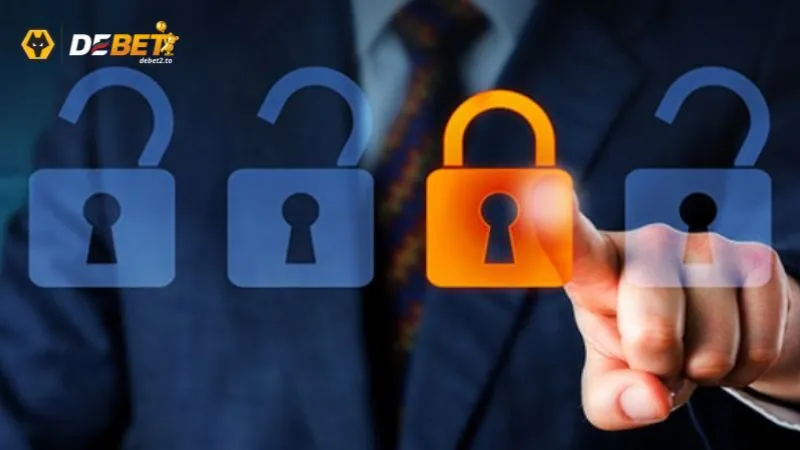DEBET – Khám Phá Nhà Cái DEBET Top 1 Cá Cược Thể Thao 2024
Với kinh nghiệm dày dặn trên thị trường, nhà cái DEBET đã khẳng định vị thế là một trong những nền tảng được đông đảo người chơi lựa chọn. Chúng tôi tự hào mang đến cho mọi thành viên tham gia một sân chơi cá cược trực tuyến chuyên nghiệp và an toàn. Để hiểu sâu hơn, DEBET sẽ đồng hành cùng bạn khám phá qua bài viết dưới đây.
Giới thiệu tổng quan về sàn cá cược DEBET
Được thành lập tại một trong những cái nôi của ngành công nghiệp game bài đổi thưởng, DEBET đã nhanh chóng khẳng định vị thế của mình trên thị trường cá cược trực tuyến. Với lịch sử hình thành lâu đời, nền tảng đã trở thành một thương hiệu uy tín được công nhận bởi các cơ quan quản lý game bài hàng đầu tại châu Âu. Sau nhiều năm hoạt động và không ngừng phát triển, cổng game đã mở rộng thị trường đến nhiều quốc gia châu Á trong đó có Việt Nam. Tại thị trường Việt Nam, cái tên DEBET2.TO luôn là cái tên được săn đón cũng như sở hữu một lượng lớn tín đồ tham gia mỗi ngày. Đặc biệt, nhà cái DEBET liên tục lọt top đầu những nền tảng uy tín được bình chọn bởi cộng đồng game thủ. Bên cạnh đó, sàn cá cược trực tuyến còn được biết đến với nhiều chương trình khuyến mãi hấp dẫn cùng tỷ lệ kèo cược cực kỳ cạnh tranh. Số lượng thành viên gia tăng không ngừng là minh chứng rõ ràng nhất cho sự thành công của nền tảng.

Triết lý kinh doanh của DEBET
Tại DEBET2.TO, chúng tôi luôn đặt sự hài lòng của người chơi lên hàng đầu. Mọi hoạt động kinh doanh của cổng game đều được thực hiện dựa trên nguyên tắc và giá trị cốt lõi mà chúng tôi đã cam kết với hội viên bao gồm:
Đặt người dùng làm trung tâm
Nhà cái DEBET luôn hoạt động với phương châm công khai, minh bạch. Nhờ đó, các cược thủ có thể tận hưởng không gian giải trí ấn tượng tại nền tảng. Đối với quá trình đăng ký tài khoản, nhà cái luôn cập nhật chi tiết tất cả các điều khoản để các hội viên nắm rõ cũng như để bảo vệ quyền lợi thành viên tối đa.
Tạo dựng một địa điểm giải trí văn minh
Nhà cái luôn nỗ lực xây dựng một môi trường giải trí công bằng, chuyên nghiệp, đảm bảo quyền lợi bình đẳng cho tất cả hội viên. Khi lựa chọn DEBET2.TO làm điểm dừng chân, các game thủ sẽ không bao giờ cảm thấy thất vọng bởi phong cách làm việc uy tín và quy chuẩn mà chúng tôi luôn theo đuổi. Các sản phẩm của hệ thống đều được kiểm tra kỹ lưỡng trước khi ra mắt nhằm chắc chắn chất lượng cao nhất cho bet thủ. Ngoài ra, nhà cái DEBET còn sở hữu đội ngũ IT giàu kinh nghiệm, luôn sẵn sàng hỗ trợ và xử lý ngay lập tức khi có sự cố kỹ thuật xảy ra. Điều này giúp trải nghiệm giải trí luôn mượt mà cũng như được nâng lên một đẳng cấp hoàn toàn mới.

Tìm hiểu về tính hợp pháp của DEBET
Một trong những yếu tố quan trọng giúp nền tảng DEBET2.TO khẳng định vị thế của mình trên thị trường cá cược trực tuyến chính là giấy phép hoạt động hợp pháp được cấp bởi MGA (Malta Gaming Authority). MGA được biết đến là cơ quan quản lý cá cược danh tiếng, khắt khe hàng đầu châu Âu. Chính vì vậy, việc sở hữu giấy phép này chứng tỏ nhà cái DEBET đã đáp ứng đầy đủ các tiêu chí nghiêm ngặt về pháp lý, bảo mật trong hoạt động kinh doanh. Bên cạnh giấy phép MGA, DEBET còn tự hào là một trong số ít cổng game đạt được chứng nhận bảo mật thông tin ICA. Điều này đã khẳng định cam kết của chúng tôi trong việc bảo vệ dữ liệu cá nhân của khách hàng một cách tuyệt đối. Với hệ thống bảo mật hiện đại và các biện pháp quản lý thông tin chặt chẽ của DEBET2.TO, anh em có thể tin tưởng rằng mọi thông tin của thành viên đều được bảo mật an toàn, tránh mọi rủi ro bị rò rỉ hoặc đánh cắp thông tin.

Những yếu tố đặc biệt đã xây dựng nên thương hiệu DEBET
Việc lựa chọn đầu tư đặt cược tại DEBET là một quyết định ssẽ không khiến bạn cảm thấy hối hận. Chúng tôi luôn chú trọng hoàn thiện chất lượng dịch vụ đến từng chi tiết nhỏ nhất nhằm đem lại những giây phút giải trí tuyệt vời cho cược thủ. Chính sự tỉ mỉ, chuyên nghiệp trong từng khâu phục vụ đã giúp nhà cái DEBET chinh phục hàng triệu game thủ.
DEBET hỗ trợ đa nền tảng
Nền tảng được nâng cấp để mang đến sự linh hoạt khi sử dụng cho người dùng với hai lựa chọn đó là truy cập trực tiếp qua website hoặc tải ứng dụng trên điện thoại di động. Chỉ cần vài phút cài đặt cơ bản, anh em đã có thể ngay lập tức tham gia khám phá những thử thách đầy kịch tính tại sàn cá cược đẳng cấp DEBET. Ứng dụng được tối ưu hóa để tương thích với hầu hết các dòng điện thoại thông minh phổ biến hiện nay. Vì vậy, bạn có thể dễ dàng truy cập và tận hưởng trải nghiệm suôn sẻ, không gián đoạn. Dù ở hình thức nào thì DEBET2.TO luôn mang đến không gian giải trí chất lượng, đáp ứng mọi nhu cầu của bet thủ một cách trọn vẹn nhất.

Kho tàng trò chơi đồ sộ
Hệ thống DEBET cung cấp nhiều sảnh game đa dạng, mỗi sảnh đều chứa đựng một thế giới trò chơi độc đáo với vô vàn lựa chọn hấp dẫn. Từ những trò chơi dân gian quen thuộc như bắn cá, Keno đến những sảnh casino đẳng cấp quốc tế, tất cả đều có mặt để đáp ứng mọi nhu cầu của thành viên DEBET2.TO. Không chỉ chú trọng vào các trò chơi, nền tảng còn đầu tư kỹ lưỡng vào các hình thức kèo cá cược với cơ cấu quy đổi tiền thưởng cao. Tỷ lệ kèo hấp dẫn giúp các cược thủ dễ dàng gia tăng cơ hội chiến thắng đồng thời thu hút số lượng lớn hội viên VIP đến với hệ thống. Sự kết hợp này đã góp phần làm nên sự đẳng cấp của DEBET trên thị trường.
Hệ thống DEBET bảo mật tuyệt đối
Ngay từ phần đầu, chúng tôi đã thể hiện cam kết đặt sự ưu tiên vào việc bảo vệ thông tin cá nhân của người chơi. DEBET2.TO đảm bảo rằng mọi dữ liệu của người dùng sẽ được giữ an toàn tuyệt đối tạo nên một môi trường giải trí đáng tin cậy. Cổng game cũng sử dụng các công nghệ bảo mật hiện đại nhất vì vậy anh em có thể yên tâm khi tham gia. Để tăng cường an ninh, nhà cái DEBET đã áp dụng hệ thống bảo vệ dữ liệu tiên tiến cụ thể là công nghệ mã hóa SSL 128-bit nhằm ngăn chặn mọi rủi ro tiềm ẩn về an ninh mạng. Giải pháp này có thể ngăn chặn mọi hành vi xâm phạm trái phép hay rò rỉ thông tin.

Cơ cấu luật chơi DEBET tuân theo quy chuẩn quốc tế
Hệ thống luật chơi tại đây được thiết kế theo tiêu chuẩn quốc tế để mọi thành viên từ nhiều nơi trên thế giới có thể dễ dàng trải nghiệm. Mọi trò chơi đều không áp dụng các “luật rừng” để gây khó khăn cho game. Các quy tắc trong từng trò chơi luôn được DEBET công khai rõ ràng giúp bet thủ dễ dàng nắm bắt và hiểu rõ trước khi nhập cuộc. Nhờ đó, các cược thủ không chỉ tránh được những bỡ ngỡ mà còn có thể gia tăng khả năng giành điểm thưởng một cách hiệu quả. Với những ưu điểm như vậy, DEBET2.TO mong muốn tạo ra một sân chơi công bằng nơi mà kết quả của mỗi ván cược đều phụ thuộc vào may mắn và kỹ năng.
Hàng ngàn sự kiện khuyến mãi với giá trị thưởng siêu khủng
DEBET luôn tạo điều kiện cho mọi hội viên với nhiều chương trình khuyến mãi giá trị. Dưới đây là một sự kiện ưu đãi mà bạn có thể tham khảo khi đăng ký tham gia tại đây:
- Phần thưởng chào mừng: Chúng tôi áp dụng chương trình thưởng nạp lần đầu lên đến 110% giá trị nạp cho người đăng ký mới với số tiền thưởng tối đa lên đến 11 triệu đồng. Đây là cơ hội vàng mà anh em cần phải nắm bắt để có thêm vốn trải nghiệm mọi dịch vụ tại nhà cái DEBET.
- Thưởng nạp lần thứ hai: Tặng ngay 30% giá trị nạp với mức thưởng tối đa có thể đạt đến 15 triệu đồng khi thực hiện lần nạp tiền thứ hai vào tài khoản. Ngoài ra, cược thủ có thể rút tiền thưởng này sau khi hoàn thành điều kiện cược tối thiểu 12 lần.
- Hoàn trả 1,5% mỗi ngày: DEBET2.TO cũng tặng bạn 1,5% tiền cược mỗi ngày mà không giới hạn số tiền hay thời gian. Tài khoản của người chơi sẽ được cập nhật số tiền hoàn trả này.

Điểm qua những sảnh cược phổ biến tại DEBET
Khi đến với sân chơi DEBET của chúng tôi, anh em sẽ được tận hưởng đa dạng các sản phẩm, lĩnh vực được chú ý hàng đầu hiện nay. Các trò chơi truyền thống quen thuộc cùng những xu hướng cá cược mới nhất đều được nền tảng tuyển chọn kỹ lưỡng và cập nhật liên tục. Dưới đây là những tựa game chắc chắn bet thủ không thể rời mắt:
Cá cược thể thao
DEBET2.TO cũng là một thiên đường cá cược thể thao trực tuyến chắc chắn mang đến cho bạn những trải nghiệm chưa từng có. Game thủ có thể tham gia đặt cược vào hàng trăm sự kiện thể thao mỗi ngày với các giải đấu lớn nhỏ khác nhau.
- Nhà cái DEBET liên tục cập nhật các giải đấu bóng đá nổi bật như Premier League, La Liga, Champions League. Ngoài bóng đá, nền tảng còn hỗ trợ đa dạng các môn thể thao khác như tennis, bóng rổ, bóng chày để đáp ứng mọi sở thích của các tín đồ.
- Giao diện thiết kế thân thiện, trực quan giúp anh em dễ dàng tìm kiếm cũng như nhanh chóng thực hiện các thao tác đặt cược. Ngoài ra, DEBET còn có tỷ lệ cược cạnh tranh và đa dạng các loại hình đặt cược như cược chấp, cược tài xỉu, cược phạt góc,…
- Tính năng cá cược trực tiếp (Live Betting) là điểm nhấn nổi bật tại đây. Tính năng này cho phép bạn đặt cược ngay cả khi trận đấu đang được diễn ra. Điều này tạo nên một trải nghiệm giải trí sống động, kịch tính hơn bao giờ hết.
- DEBET2.TO còn cung cấp đầy đủ các thống kê chi tiết cùng phân tích chuyên sâu về đội bóng, cầu thủ nhằm hỗ trợ người chơi có thêm cơ sở để đưa ra quyết định sáng suốt. Các dữ liệu chính xác và kịp thời này là công cụ đắc lực để bạn gia tăng khả năng thắng cược.
Live casino DEBET
Nhà cái DEBET cũng mang đến một không gian sòng bài trực tuyến vô cùng chân thực với hàng loạt lựa chọn từ các sảnh bài danh tiếng như WM Casino, BBIN, AG, Evo, BG. Mỗi sảnh bài đều sở hữu nhiều trò chơi đa dạng, có những nét đặc trưng riêng và mức thưởng cạnh tranh. Bên cạnh đó, nhà cái còn nổi bật với hệ thống casino live sôi động nơi người chơi có thể tương tác trực tiếp với các Dealer DEBET xinh đẹp, tinh tế. Không chỉ sở hữu ngoại hình cuốn hút mà họ còn tạo nên một không khí sôi động, siêu thực như đang chơi tại sòng bài thực tế.

Number game – Keno DEBET
Đã là một tín đồ với những con số thì không thể bỏ qua keno và number game. DEBET2.TO chính là thiên đường dành cho những sản phẩm trò chơi giải trí liên quan đến số học. Luật chơi vô cùng đơn giản, phù hợp với những tân binh mới tham gia. Anh em chỉ cần lựa chọn một con số may mắn sau đó chờ đợi hệ thống công bố kết quả.
Lô đề trực tuyến DEBET
Lô đề không chỉ là một hình thức cá cược truyền thống mà còn là một sản phẩm giải trí trực tuyến hiện đại được đông đảo người chơi yêu thích. Với giao diện nét căng, cách chơi dễ hiểu, tỷ lệ thưởng hấp dẫn, lô đề DEBET đã và đang trở thành xu hướng mới trong cộng đồng lô thủ. Tất cả kết quả xổ số miền Bắc, Trung, Nam đều được cập nhật nhanh chóng, chính xác. Bạn có thể dễ dàng theo dõi kết quả xổ số cũng như đối chiếu với những con số may mắn mà mình đã lựa chọn.
Bắn cá đổi thưởng DEBET
Săn cá đổi thưởng luôn nằm trong top đầu tìm kiếm của mọi game thủ khi đến với nhà cái DEBET. Nền tảng cập nhật liên tục các phiên bản bắn cá mới, từ truyền thống đến hiện đại. Ngư thủ được chọn nhiều chủ đề khác nhau như bắn cá thần tài, bắn cá truyền thống, bắn cá mỹ nhân ngư,… Mỗi chủ đề đều là phiên bản mang đến những đặc trưng riêng biệt. Vì thế, các tín đồ săn cá DEBET cần dành nhiều thời gian để khám phá hết những điều thú vị mà thế giới dưới nước này mang lại.

Nổ hũ jackpot siêu khủng
Nếu là fan của những trò chơi slot game đầy màu sắc thì DEBET2.TO là điểm đến lý tưởng dành cho bạn. Cổng game cung cấp đến 10 sảnh cược khác nhau cùng hàng trăm trò chơi slot chất lượng từ những nhà phát hành game nổi tiếng như CQ9, Evoplay, PG. Dưới đây là một số trò chơi slot đỉnh cao mà mọi người chơi không nên bỏ lỡ:
- Game slot 3D ấn tượng: Các tựa game này không chỉ có đồ họa sắc nét mà còn đi kèm với hiệu ứng âm thanh sống động tạo cảm giác như đang lọt vào một thế giới huyền bí. Ngoài ra, nhờ chủ đề đa dạng từ cổ tích đến phiêu lưu, mỗi vòng quay tại DEBET sẽ mang đến những giây phút vô cùng bất ngờ.
- Game slot thể thao: Kết hợp giữa đam mê thể thao và cơ hội trúng thưởng lớn, các game slot thể thao sẽ đem lại cơ hội trải nghiệm cả hai. Với chủ đề liên quan đến bóng rổ, bóng đá cùng nhiều môn thể thao khác, đây chắc chắn là lựa chọn không thể thú vị hơn.

Một số trò chơi khác tại DEBET
Không chỉ dừng lại ở các game slot hấp dẫn DEBET2.TO còn mang đến một kho tàng giải trí phong phú với nhiều trò chơi đặc sắc khác như:
- Đá gà DEBET trực tuyến: Dành cho những ai muốn trải nghiệm cảm giác hồi hộp, kịch tính của các trận đấu đá gà đỉnh cao ngay tại nhà. Anh em sẽ được hòa mình vào không khí sôi động của các trường đấu nổi tiếng qua hệ thống phát trực tiếp chất lượng cao.
- Gameshow trực tiếp: Các gameshow trực tiếp như Monopoly Live hay Dream Catcher cũng là điểm nhấn không thể bỏ qua tại DEBET2.TO. Những trò chơi này không chỉ dựa vào yếu tố may mắn mà còn đòi hỏi người chơi phải có kỹ năng phân tích tốt.
Hướng dẫn cách tham gia đặt cược tại DEBET
Để trở thành thành viên tại đây, trước tiên bạn phải có cho mình một tài khoản cá nhân. Việc đăng ký rất đơn giản, cược thủ chỉ cần thực hiện ba bước sau đây:
- Bước 1: Truy cập vào link https://www.10-0-0-0-1.io/ địa chỉ chính thức của DEBET bằng cách sử dụng link web hoặc ứng dụng di động mà chúng tôi cung cấp. Tại trang chủ, hãy tìm và nhấn vào mục “Đăng ký” nằm ở góc phải phía trên cùng của màn hình.
- Bước 2: Điền đầy đủ các thông tin cần thiết vào biểu mẫu đăng ký. Hãy đảm bảo rằng mọi dữ liệu được nhập chính xác, đầy đủ để quá trình tạo tài khoản diễn ra thuận lợi.
- Bước 3: Cuối cùng kiểm tra lại tất cả thông tin mà anh em đã cung cấp. Sau khi chắc chắn, nhấn vào nút đăng ký để hoàn tất quá trình. Thông thường chỉ mất từ 1 đến 2 phút để hệ thống nhà cái DEBET thông báo xác nhận thiết lập tài khoản thành công.

Kết luận
Nhà cái DEBET đã khẳng định vị thế của mình như một sảnh cá cược uy tín và chuyên nghiệp, cung cấp dịch vụ hợp pháp với chất lượng vượt trội. Vậy nên, bạn còn chần chừ gì nữa mà không tham gia DEBET2.TO ngay để có những giây phút giải trí lôi cuốn nhé!

LÊ BẢO
“Tôi đã trải nghiệm nhiều nhà cái trực tuyến, nhưng debet2.to là một trong những nhà cái tốt nhất mà tôi từng gặp. Họ cung cấp một loạt các trò chơi phong phú và cơ hội cá cược hấp dẫn. Tôi cũng đã rút tiền thành công nhiều lần từ sân chơi này mà không gặp bất kỳ vấn đề nào.”

ANNA NGUYỄN
“nhà cái Debe là nền tảng cá cược đáng tin cậy. Tôi đã chơi trên đó trong một thời gian dài và chưa bao giờ gặp phải bất kỳ vấn đề nào liên quan đến việc rút tiền hay bảo mật thông tin cá nhân. ”















